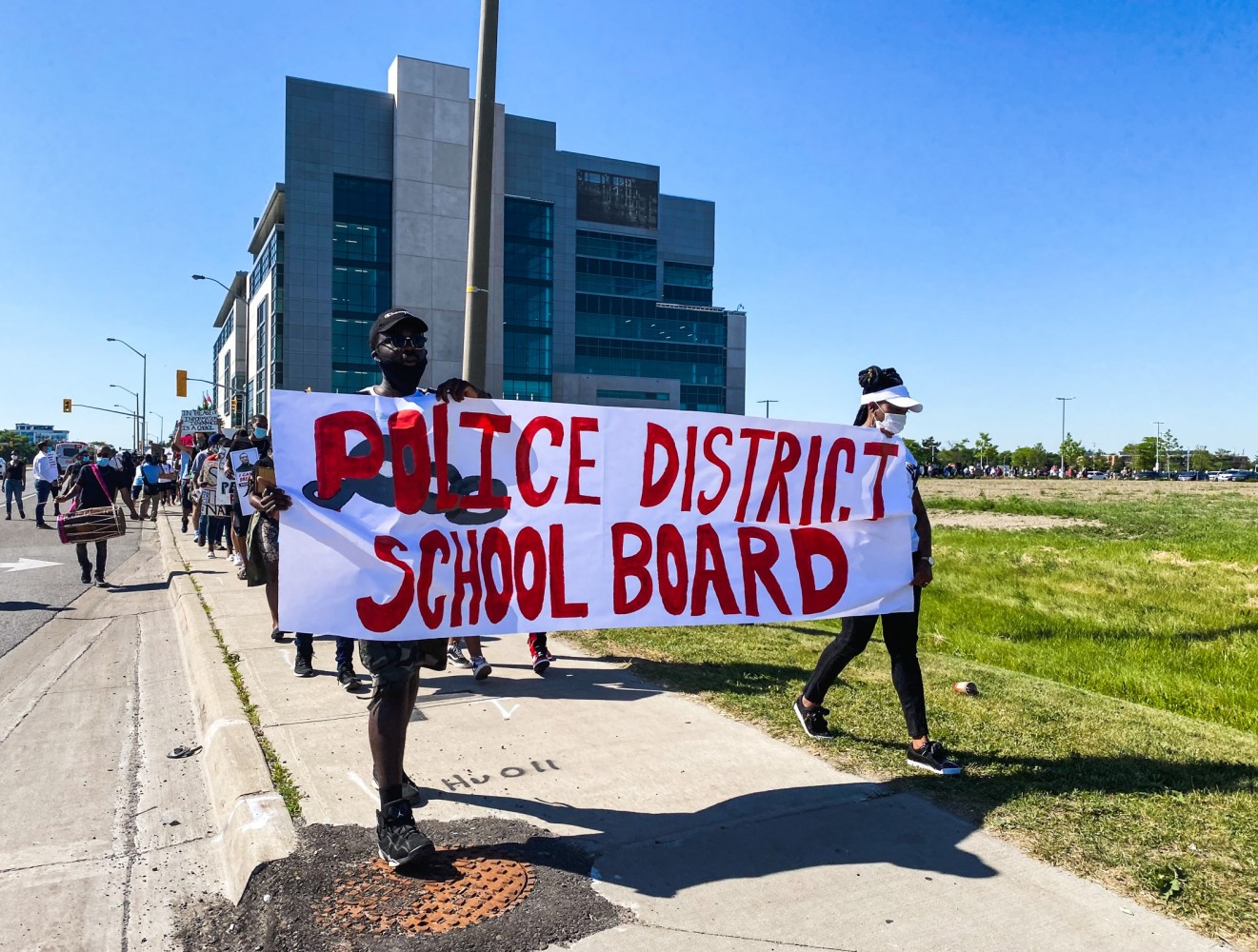
Would a Liberal provincial government finally confront sweeping systemic discrimination in Peel?
Saying demographic diversity has come with its challenges across Peel is like pointing out ice is cold.
With dramatic shifts over four decades that have completely altered the region's ethno-racial makeup, systemic discrimination and institutionalized racism have been so deeply imbedded in many of Peel’s institutions they have become the defining characteristics that shape the culture inside many of its most influential organizations, those that impact the day to day lives of residents most profoundly.
When Peel District School Board was deemed a disturbingly discriminatory institution or when Peel Police was found to actively patrol using racist approaches on the citizens it’s supposed to protect, these realities meant the vast majority of residents—those who are visible minorities—are abused economically and emotionally as part of everyday life in their own backyard.
They simply do not have the same opportunities as their white counterparts, who, despite being the clear minority, run the institutions they maintain control over as if they are the overwhelming majority.
Peel District School Board, the second largest English school board in Canada, is responsible for educating a student body that is almost 85 percent non-white, while about two thirds of teachers and an even higher percentage of administrators, including principals and vice principals are white.
Issues of discrimination have dogged the board for more than two decades, from its disgraceful attempt in the '90s to prevent Sikh students from wearing their kirpan, to the presence of one of Canada’s most vile white supremacists among its teaching ranks for decades.
In 2020, the situation inside PDSB became so disturbing, the PC government had to strip its trustees of their governance powers and take control of the board after a number of disturbing high profile incidents involving trustees. The director of education at the time was quickly fired by a provincially appointed supervisor who is still responsible for governance of the board.
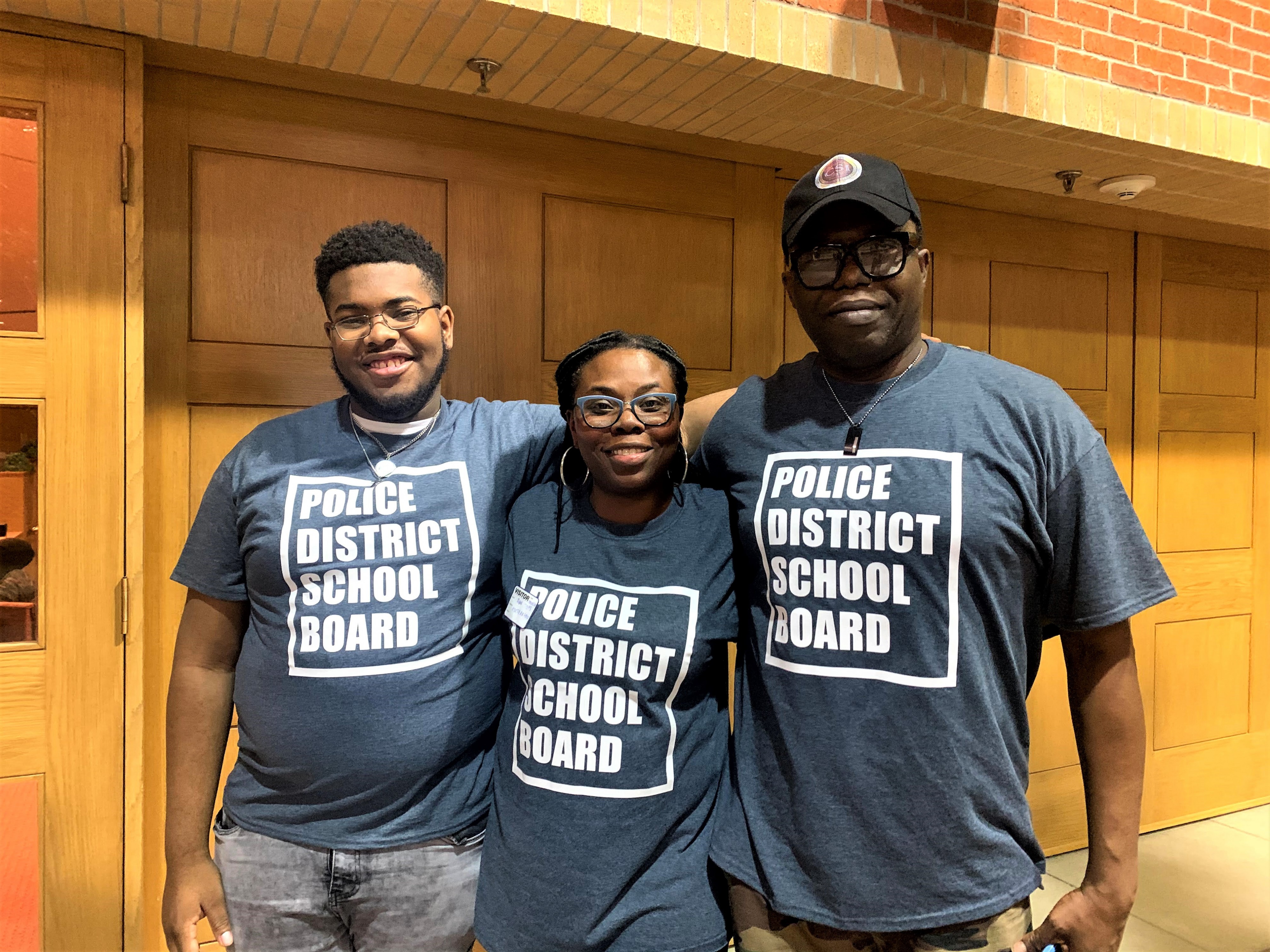
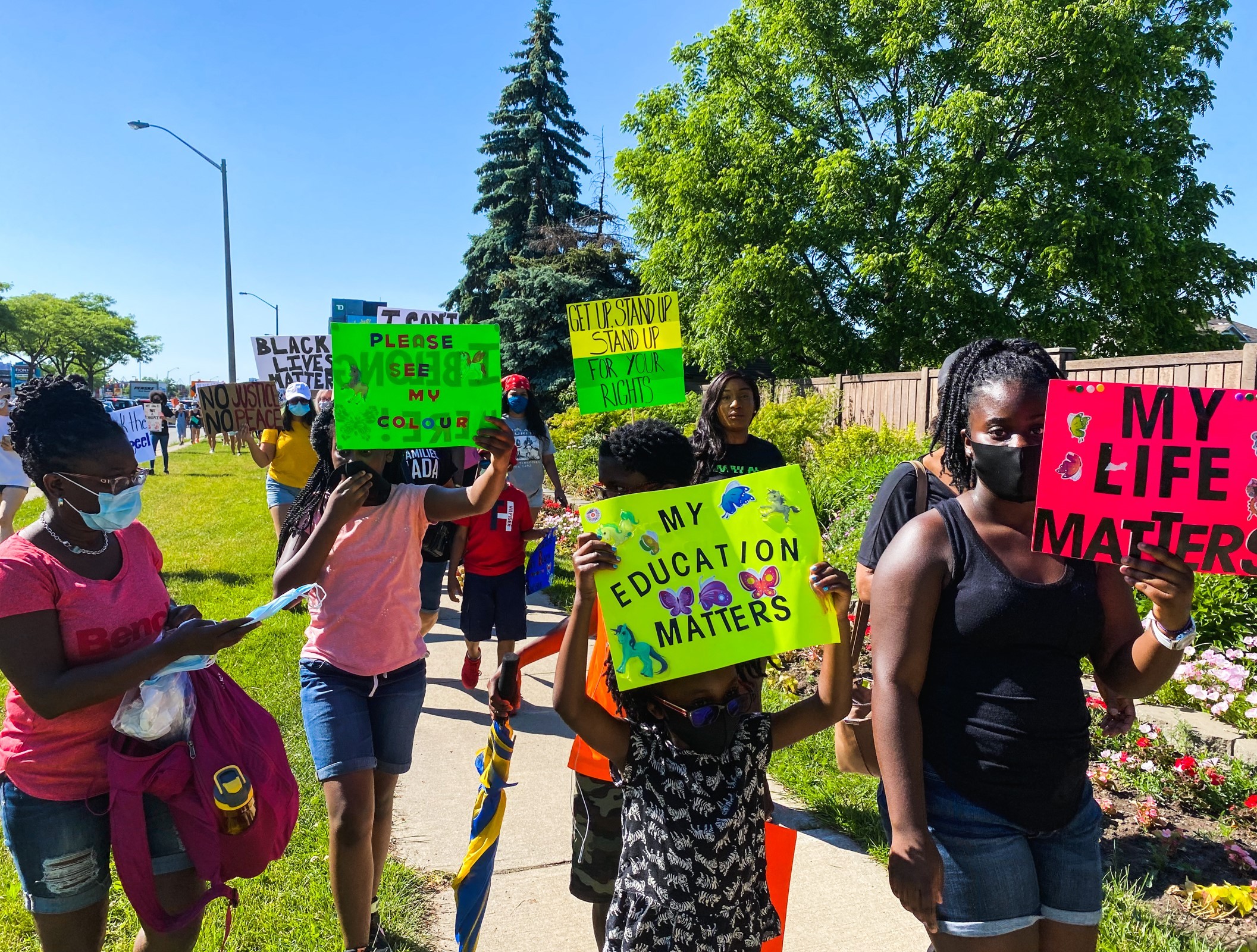
The Province had seen enough after Black community members in 2020 demanded sweeping changes inside PDSB following decades of systemic discrimination.
(The Pointer file photos)
One example of just how shockingly ingrained racism inside PDSB is, was a letter the board was forced to write to its own staff at one of its schools. In June of 2020, the communication was meant as an apology after the principal, during a staff meeting to address students in need of special attention, said about one pupil, “the student comes from a typical Jamaican family where the mother does nothing…”.
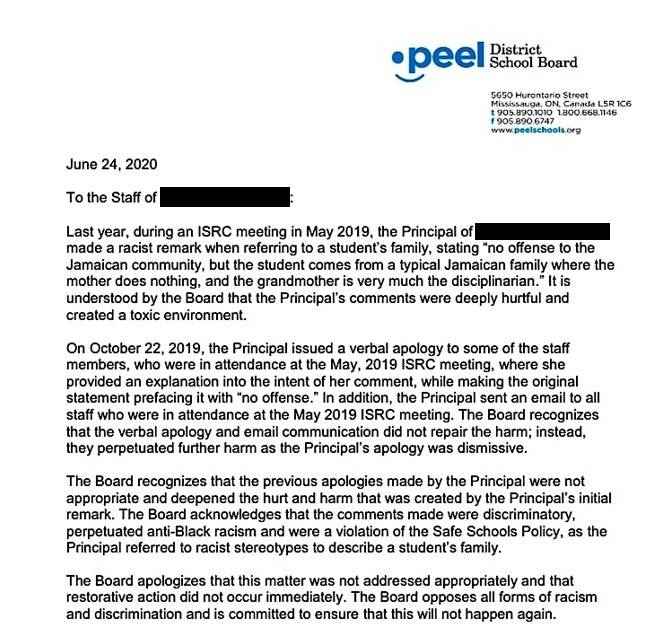
Sources inside the school told The Pointer at the time that some educators were devastated by the remark and many feared for the well being of their students.
It was nothing new.
Paul Fromm, who publicly bragged about creating a white “supreme race” through selective breeding, and was a prominent leader in the same white supremacy group that influenced the man who murdered nine Black citizens in a South Carolina Church in 2015, openly pushed his racist views on the national stage while also openly working as a teacher in the PDSB for more than 20 years.
A man who led racist protests, has regularly spoken on the white nationalist radio show Stormfront, is the focus of a Hamilton police investigation for allegedly spreading the New Zealand Mosque shooter's manifesto on the website of one of his racist groups, who publicly said, "I'm a white nationalist. I'm proud of our European heritage and I want to keep it,” was openly allowed to influence hundreds of non-white students inside PDSB classrooms for more than two decades, while leaders of the organization failed to see the horrible reality its students had to face on their own.
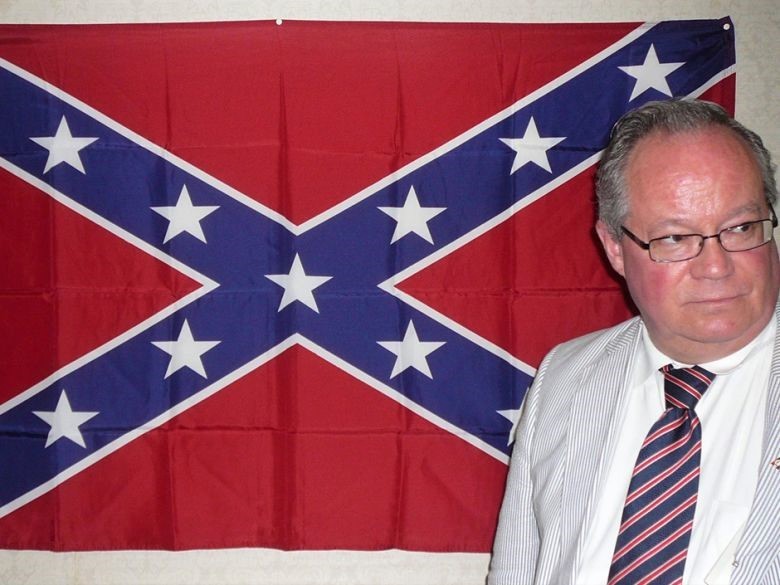
Prominent white supremacist Paul Fromm taught in the PDSB for more than 20 years while he openly expressed racist views to followers across North America.
(Image Facebook)
Over at the Peel Regional Police force, around the same time, officer B.J. Sandhu, was putting up with much of the same starting in 1989 when he joined the force. After finally deciding he had enough, in 2013 Sandhu, whose list of commendations for policing excellence (he helped solve numerous high profile cases) was extensive, filed a discrimination case in 2013 when he was refused the opportunity to seek a promotion.
The evidence in the Ontario Human Rights Tribunal hearings was shocking. A culture of widespread racism was detailed in documents and in witness testimony.
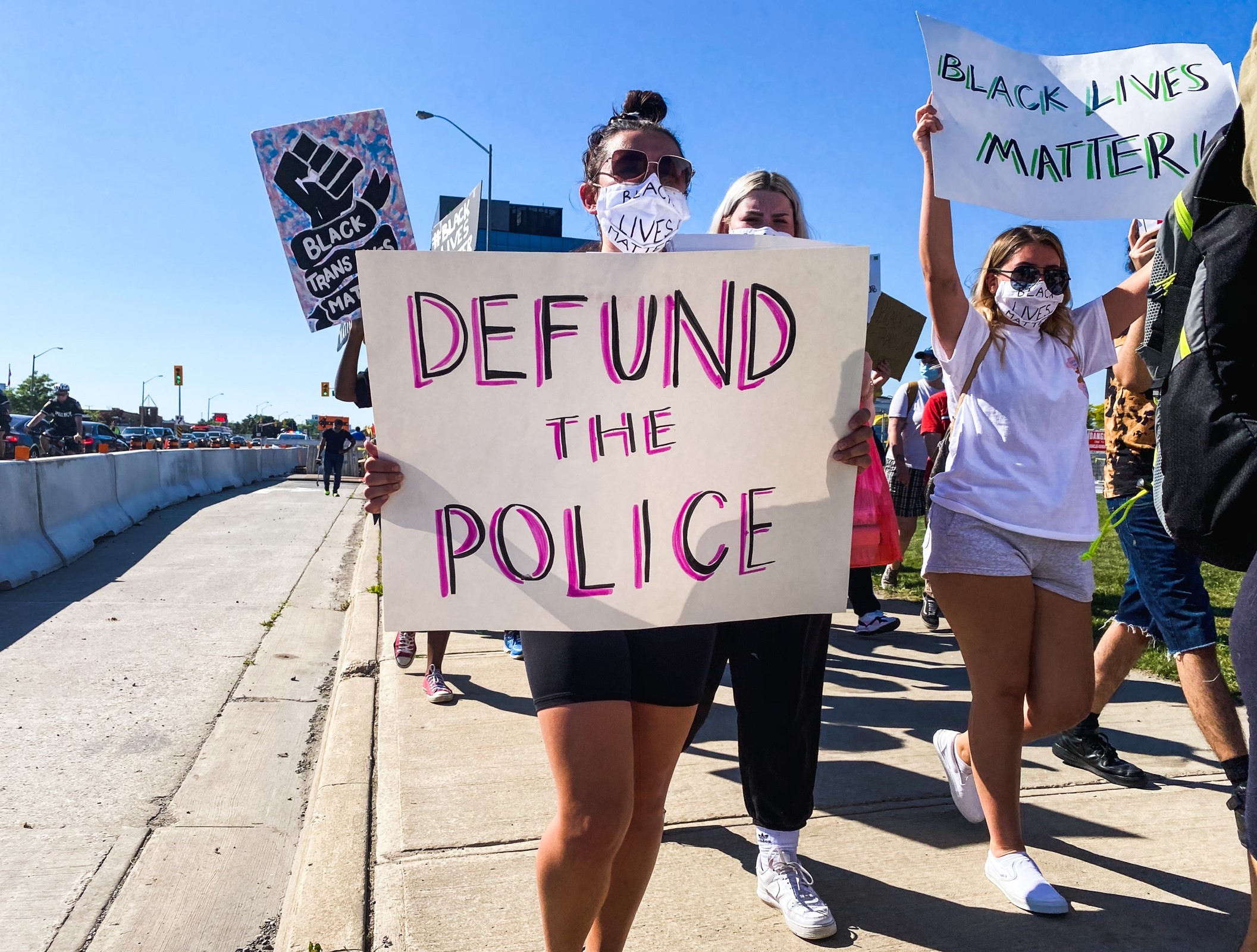
A 2020 protest march in Mississauga.
(The Pointer file photo)
The finding was that Sandhu had been discriminated against due to his race and that the force’s culture was broadly racist toward the visible minority communities it is supposed to serve.
The ruling stated Peel Police “generally” devalued policing in the huge South Asian community because it involves “the South Asian population”.
Peel’s Black communities have for decades pushed back against the targeted police practice of carding, which data showed was aimed at their members.
Like the PDSB trustees who defended discriminatory practices for decades, former Peel Police chief Jennifer Evans not only refused to acknowledge the harmful effects of targeted police carding in Black communities, she publicly defended it and claimed its prohibition resulted in increased rates of violent crime. There was no evidence or data that supported her unsubstantiated claims.
The damage done to residents in Brampton and Mississauga, almost 70 percent of whom are not white, is hard to quantify.
A report in 2020 put together by ETIO Public Health Consultants and Public Health Insights addressed the need to approach systemic discrimination in Ontario, particularly in regions like Peel, holistically, instead of reacting disjointedly to the same problem in isolated cases. The report captured the many dimensions of discrimination in Ontario, and issued guidelines for the Province and policymakers to consider.
Instead of isolated responses to discrimination every time an institution is found to have systemic problems, the recommendations aimed to establish sweeping policies to address harmful dynamics seen across Ontario’s most prominent sectors.
Project lead Mofiyinfoluwa (Dami) Lawal told The Pointer when the report was released that its purpose was to create steps that can lead to broadly effective solutions and firm policies.
Lawal said the lack of action and broad response in Ontario is partly because leaders and other policymakers have failed to understand racism is a public health crisis. An institutionalized culture antithetical to Canadian values of equity and inclusion has prospered in the absence of rules and strategies to ensure all organizations use these principles as their foundation.
In Peel, the following organizations have been criticized over the last five years after audits and other work revealed specific forms of institutionalized discrimination:
-
Peel police has a culture of intolerance and carried out discriminatory hiring
-
It carded Black residents at more than three times the rate compared to whites
-
It failed to fairly promote visible minority officers
-
It has failed to hire in a way that reflects the communities it serves
-
It systematically targeted Black students for suspension
-
It streamed Black students into educational pathways that cut them off from opportunities
-
The City of Brampton has failed to reflect its community’s demographics in hiring and promotions
-
The City of Mississauga similarly does not reflect its own demographics inside City Hall
-
The Peel Police Services Board fails to include any Black representation among its board members, ignoring concerns of key stakeholder communities in Brampton and Mississauga
-
The Region of Peel, which serves a population that is mostly non-white, did not have one member at the start of 2022 who is non-white among its executive leadership team which is exclusively white.
The list could continue for pages, to include disturbing realities in Peel’s court system, other social services, healthcare, other areas of regional and municipal government and the private sector.
Recognizing the frustration more and more voters are feeling about the lack of opportunities and the lack of action around systemic discrimination, one of the three major political parties in the province is rolling out a plan ahead of the June 2 Ontario election.
This week, Ontario Liberal Leader, Steven Del Duca, announced his Party’s commitment to finally address the devastating impact of systematic racism in schools and policing.
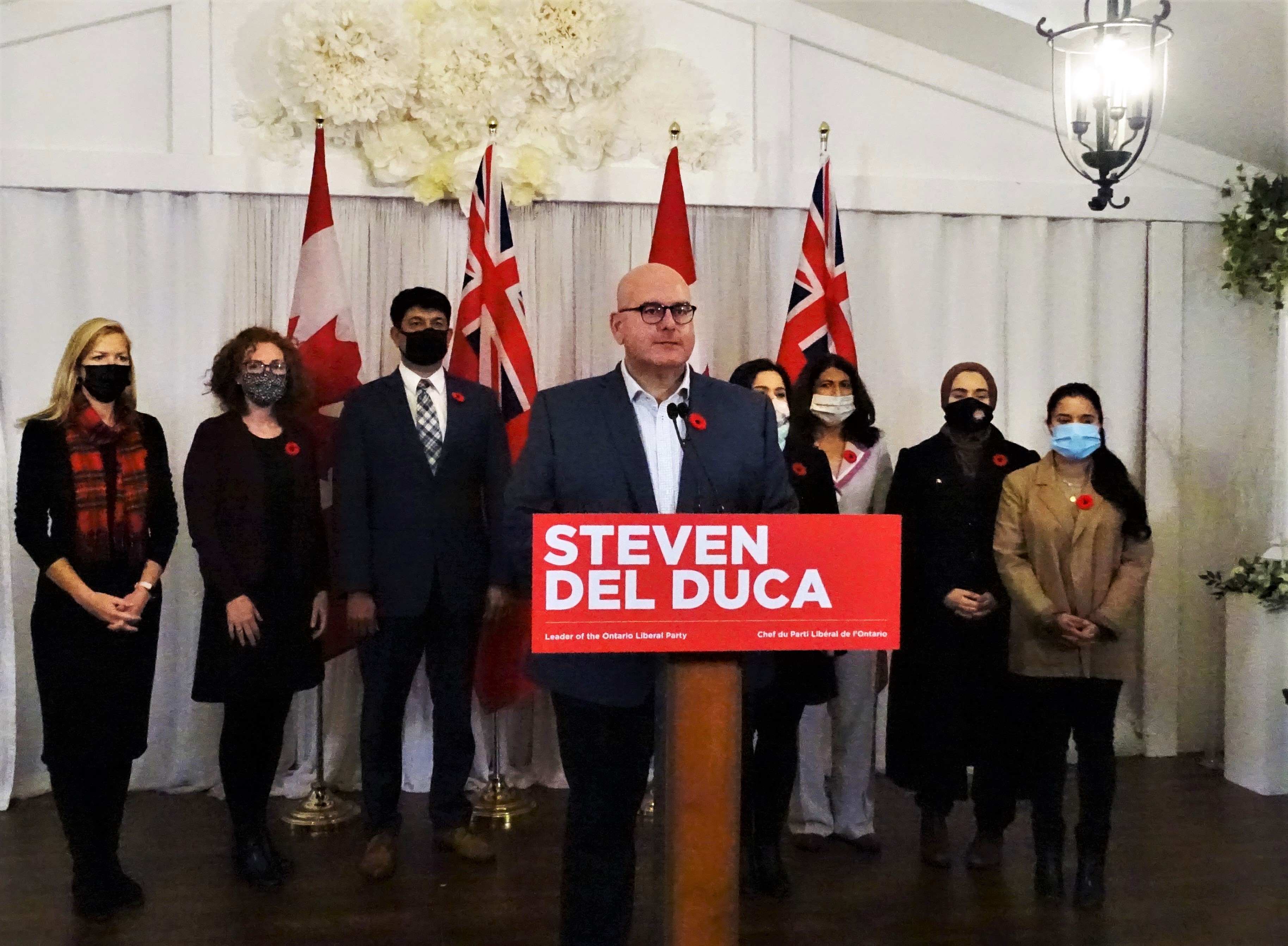
Liberal Leader Steven Del Duca this week announced a commitment to confront systemic discrimination in education and policing if his party forms government.
(Photo Natasha O'Neill/The Pointer)
Del Duca is promising a number of sweeping policies aimed at the root causes of discrimination. Light on details, they will address police interactions with residents, the makeup of police boards and equity among the officer ranks.
In education, the Liberals promise to end streaming for both grades 9 and 10 (which the PCs have already moved toward) and funding specific programs to combat racism under a new cabinet minister role dedicated to fighting systemic discrimination.
He also pledged to pass the Our London Family Act to combat the alarming rise of Islamophobia and give police more tools to deal with hate crimes.
“Doug Ford’s Conservatives have refused to do all that is needed to fight racism in Ontario,” Del Duca said when announcing the new measures in Toronto this week. “Instead, they cut funding to anti-racism programs, failed to give prosecutors the resources needed to ensure hate-crimes do not go unpunished. Our plan will invest in police forces that look more like the communities they serve.”
According to a Liberal spokesperson, the Party has been holding policy consultations with residents across the province.
“The Ontario Liberal platform has had extensive input from BIPOC communities on the topic of community safety,” the spokesperson said.
In Peel, advocates are already wondering why the Liberals still have to ask communities about the problems members constantly face.
“We're not trying to find out what is happening, we know what is happening,” Idris Orughu, who has led community initiatives to fight discrimination inside the PDSB and Peel Police, said. “The question is, do we have the political will and political desire to put a stop to it?”
End Streaming in Grades 9 and 10
Across Ontario students in high school are asked to pick between ‘applied’ and ‘academic’ courses, in later years these turn into college or university credits forcing the student early on to make choices that will determine their educational fate.
Minister of Education, Stephen Lecce, says Ontario is one of the last provinces that still has such pathways. For Peel Region students, these paths have been used against children, by teachers and administrators who intervene in the future of a student based on preconceived biases, which are often subconscious. At PDSB, 84 percent of students are not white, while approximately 70 percent of teachers and administrators are white.
In the first provincial review of PDSB following the Province’s intervention to confront systemic discrimination, published in March 2020, investigators found Black and Indigenous students were being disproportionately impacted by streaming.
“A former student, who is Black, spoke to us about their regret in following teachers’ advice to take applied courses and enroll in a vocational program, despite high marks; following that advice left the student excluded from any university options and limited choices in college programs,” the review, which backed up anecdotal evidence with quantified data, revealed.
Black students made up about 10 percent of the student population, but for Grade 9 and 10 (in 2018-19) they made up 21.7 percent of those in applied streams, more than twice their representation.
After a second review, Lecce issued 27 binding directives to the board, one of which was to pilot destreaming in Grades 9 and 10. This led the government to announce in 2020 that destreaming would occur across Ontario in Grade 9.
That September, Lecce launched a new Grade 9 math curriculum removing the two streams and allowing students to focus on financial literacy and coding.
In late 2021, the government announced in September 2022 Grade 9 students would no longer have the option of applied or academic credits in any courses. For now, Grade 10 students still have the choice.
Orughu believes to solve systematic racism in all schools the government needs to involve the teachers’ unions.
“Addressing this without addressing the union does not get you anywhere,” Orughu told The Pointer. “Because we've seen teachers who have been involved in some of these [racist] behaviours. If somebody robs a bank and they continuously do that, and they are guaranteed their job, what will make them want to change?”
He believes those who have resisted change within schools should be held accountable.
“It has to be holistic, the piecemeal approach does not work. Addressing one board is very limited, it should be a province-wide approach,” Orughu said.
Del Duca did not address how teachers are hired and promoted or policies that would force unions to incorporate equity and inclusion in their practices. He focussed on putting an end to streaming in grades 9 and 10.
According to a February 2021 progress report after the Province stripped the board’s trustees of their governance authority, PDSB started with the destreaming of Grade 9 English and Math classes with some site-specific schools discontinuing streams in other areas. The announcement from the Liberals did not come with a timeline of how quick they would implement the policy.
It remains to be seen how the Province plans to enforce streaming, after some educators inside PDSB made it clear they want to protect the harmful practice.
In a stunning revelation, The Pointer previously reported that one principal, who oversaw a school with a large Muslim student body, stated during a staff meeting that destreaming would lead to some students making “bombs” in science class.
The Liberals have also promised to “reverse” cuts by the PC government and will add funding back into Ontario’s 2017 Anti-Black Racism Strategy, Black historical sites and community centres. The PCs cut millions from anti-racism initiatives, specifically $25 million from education funding dedicated to programs for extra support for Black, Indigenous and racialized students.
Rabia Khedr, executive director of the Muslim Council of Peel, explained the incoming government should also invest in strengthening the existing education curriculum around equity and inclusion.
“I think there should actually be a component of inclusion in the classroom and in the school system,” she told The Pointer. “We need to sort of broaden that, and actually have a curriculum lens around inclusion of human rights.”
Khedr said education is the key to confronting values that go against what Canadian society stands for in our modern world.
“Discrimination is taught, so we need to unteach it,” she said. “It needs to be there from the beginning… . If you create those conversations early on those children when they go into the community, when they go home, when they engage in other spaces where adults around them are introducing bias, prejudice, discrimination, racism, Islamophobia, children will be equipped to challenge those [ideas].”
Hire Police Officers Who Reflect the Community
The majority of the promises made by Del Duca this week involved dismantling discrimination within police forces and the police service boards that oversee them. One issue that plagues both Peel Regional Police (PRP) and the Police Services Board (PSB) is the lack of representation from the communities they serve.
In 2020, there were 2,236 uniformed officers in the PRP. Visible minorities, who represent about two thirds of the population in Mississauga and Brampton (the only two municipalities the force polices; Caledon is served by the OPP) only accounted for 27.9 percent of the force, while 1.1 percent were Indigenous.

There has been a noticeable difference in the number of racialized uniformed Peel Police officers since 2016.
(Graphic from Natasha O’Neill / Datawrapper)
A scathing 2019 report commissioned by the Peel Police Services board, after mounting pressure from the public, conducted by the Canadian Centre For Diversity and Inclusion showed a force not only failing to represent the community but pushing back against change.
In 142 pages, the CCDI report described a harsh, toxic police force that punished those who spoke out and covered its eyes when systematic racism was raised. It included one-on-one interviews with senior PRP staff, two public town halls and a survey of employees garnering 1,808 reponses out of the 3,048 staff and civilian officers at the time.
It became clear through the extensive research that problems persisted within senior leadership. Officers described the organization as “change-averse” and “elitist”. The report said almost three quarters of police leaders and members of the board “do not seem to recognize that barriers exist or [believe they] rarely exist for certain groups at Peel Regional Police.”
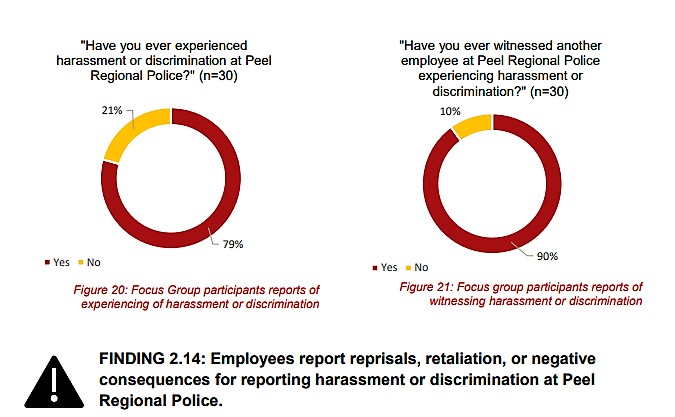
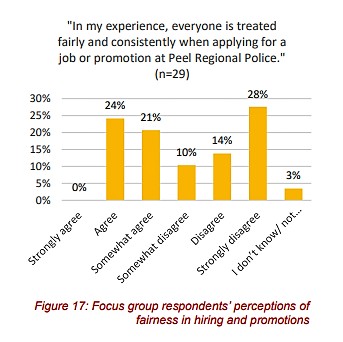
(Graphics from Canadian Centre for Diversity and Inclusion)
Promoting those who represent the community and align with its values will mean reaching down from the lower ranks to slowly transform a culture shaped by many of those still in the senior ranks occupying positions of influence.
Gurpreet Malhotra, head of Indus Community Services, believes creating effective advisory boards to help ease police forces into more diversified thinking is a good step.
“With police, with boards of education, where there’s been pain, sometimes we get stuck on the pain,” he told The Pointer. “We need to honour that some things didn't go right and some things went horribly wrong. But we can't just focus on the pain, we have to now say what are we going to do to make sure that doesn't happen again.”
It’s unclear how Del Duca’s Liberals plan on influencing hiring within police services, and appointments to boards. It has virtually no say on the former, but controls the selection of those members on boards placed there by the provincial government. Recent choices for Peel Police’s board have completely ignored representation from Black communities in the two cities, despite the dire need to rebuild broken trust with those very communities following decades of targeted carding and a number of high profile cases of racial profiling of Black citizens by Peel Police officers.
The force, under Chief Nishan Duraiappah, appears to be trying to turn things around. He signed onto an agreement with the Ontario Human Rights Commission to address the force’s woeful record on equity and inclusion. But his commitment has lacked clear details and measurable data to monitor the force’s actions.
In June, Sgt. Tony Doherty spoke to members of the force’s board about interactive steps added to the recruitment process, using social media platforms like Twitter and Instagram to reach different communities.
The recruitment team is also using various meeting platforms to hold question-and-answer sessions and one-on-one discussions with potential hires.
The implementation of the Female Inclusion Team (FIT) has reportedly been successful in attracting and retaining female applicants through a mentorship program with officers on the force.
The efforts have increased diversity in the applicant pool over the last few years. In 2018, 62.1 percent of candidates identified as racialized and 18.6 percent were women. Indigenous and persons with disabilities accounted for 0.9 and 1.6 percent of the pool.
In 2020 all these numbers increased, indicating efforts to reach out to groups previously underrepresented in the force are working. That year, racialized individuals made up 69 percent of the applicant pool and women made up 22.4 percent. Indigenous and persons with disabilities made up 1.8 percent each.
When asked how the Liberals plan to diversify forces a spokesperson explained the plan (which will be released in its entirety in the coming weeks) would see more diverse officers hired over a five year period. How this will be done remains unclear.
Disclose Diversity Statistics
After dragging its heels for decades, Peel has taken steps to provide data that show the demographics of its police force.
Since 2014 under the Equal Opportunity Plan, officers have broken down these demographics. Using available census data, PRP puts together a report each year on the changing demographics of the two cities and the police department responsible for public safety, with details about a range of strategies to align the force with the makeup of the communities it serves.

At the start of the year, Peel Region's senior executive team was exclusively white; the Region is responsible for setting the Peel Police budget.
(Images Region of Peel)
This report then informs the PRP hiring team about which segments are underrepresented, prompting strategic outreach, information sessions and further understanding of cultural and other factors inside and outside the organization that need to be addressed in order to create a force that changes with its surroundings.
Peel Police discloses the demographics of uniformed officers and breaks down its civilian staff.
If the Liberals put out a detailed plan that would help modernize the Peel District School Board and Peel Regional Police, helping confront decades of discrimination in one of the world’s most diverse regions, it could turn around the Party’s fortunes.
After the 2014 election the Liberals had control of seven of the eight ridings in Mississauga and Brampton. When the riding allocation was expanded to give Mississauga six seats and Brampton five in the 2018 election, the Liberals did not win any, eight went to the PCs and three were won by the NDP.
Malhotra doesn’t know if the Liberals will get a chance to make good on the loose commitments announced by Del Duca this week, but it’s clear that change is needed and many residents in the two cities are running out of patience.
“The reason why we have rotating party affiliation is because of ongoing dissatisfaction with people who say they're going to do something and don't,” Malhotra said. “Some days, I think it's better to say I'll do 5 percent of something but actually do it, rather than offer 25 percent of something and just go nowhere with it.”
Email: [email protected]
Twitter: @taasha__15
COVID-19 is impacting all Canadians. At a time when vital public information is needed by everyone, The Pointer has taken down our paywall on all stories relating to the pandemic and those of public interest to ensure every resident of Brampton and Mississauga has access to the facts. For those who are able, we encourage you to consider a subscription. This will help us report on important public interest issues the community needs to know about now more than ever. You can register for a 30-day free trial HERE. Thereafter, The Pointer will charge $10 a month and you can cancel any time right on the website. Thank you
Submit a correction about this story


